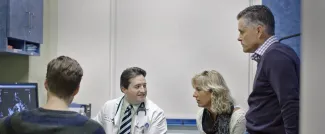VAD evaluation and selection
Patients with end-stage heart failure are evaluated to determine if a ventricular assist device is the best option and if it is safe to have the procedure. This evaluation involves many different tests.
The evaluation is also a time to learn about VADs. We will explain to you and your child how different VAD devices work and what it is like to live with one. Once the evaluation is complete, the VAD team will discuss whether your child is a candidate to receive a VAD and, if so, which one is recommended.

VAD implantation
If your child is a candidate to receive a VAD, we will let you know when the procedure can happen.
If your child is unstable, there is usually not a lot of time between when the decision is made to implant a VAD and the operation. An operation typically takes between four and eight hours. We will explain in detail the operation and how the device will be implanted in your child’s heart. For children with complex congenital heart disease, the operation is more involved because of the abnormal anatomy and scar tissue from any previous operations. VADs are often placed on the left ventricle because it is the chamber of the heart that pumps blood out of the heart and into the body. It is simply called a left ventricular assist device, or LVAD.
Post-VAD unplanned events
Blood clots, bleeding, medications
When a VAD is implanted, the body may react by forming blood clots. While your child has a VAD, they will take anticoagulants and anti-platelet drugs to prevent clots from forming. The anticoagulants are taken to reduce your child’s chance of having a stroke, which can be higher on a VAD.
Bleeding from anticoagulants is one of the most common complications of VAD therapy. The most common types of bleeding while on a VAD are a GI bleed, nosebleed, oral bleeding, or internal bleeding.
In addition to anticoagulants, children with a VAD often take blood-pressure-lowering medications and diuretics (medications that eliminate extra salt and water).
Infection
Infection is a complication that can occur around where the VAD cannulas or driveline exits the body. We try to avoid infection with regular sterile dressing changes, to keep the cannula sites clean, and close monitoring.
Discharge and follow-up
Not all children with VADs can go home. The decision depends on the kind of VAD, the underlying heart problem, your child’s current condition, and the level of support at home. The team will talk with you about what is best for your child and family.

Discharge planning, education, and home care
A number of VADs are considered manageable in an outpatient setting. We have successfully discharged 92 percent of patients who were implanted with these types of VADs, compared to the national average of 42 percent. Also, we are working with VAD manufacturers to increase the number and type of devices that can be used at home.
If your child can go home, our VAD team members will work with you to develop a plan to ensure your child, family, and community have the proper preparation and training for that big moment. First, we guide you and your child through a careful and thorough preparation process for leaving the hospital. The VAD team will also train your wider community’s first responders, teachers, employers, and clinicians (including your child’s PCP, local cardiologist, and school nurse). Most of our patients return to school full time. The plan will include medication management tips, how to change a dressing, guidelines for nutrition and physical activity, and recommendations for physical therapy, if it is needed to regain strength.
Our goal is to get your child back to as many of their normal activities as possible and to make sure you are comfortable doing so.
Discharge follow-up
Your child will have many appointments after leaving the hospital. Early on, your child will be seen in the VAD clinic once or twice a week. Our goal is to reduce this to once a month, but this will take time and depend on your child’s needs. Because of the need for close follow-up care, we ask any family member who lives more than two hours from Boston to stay locally until the team feels that you have met the criteria to go home.
Each visit can take several hours and includes many tests, including blood tests, echocardiograms, and electrocardiograms. In addition, your child will have a dressing change to make sure the driveline exit site shows no signs of infection. We will weigh your child and conduct a careful physical exam. We will review your child’s progress and discuss any questions you have and any changes in medications and treatment.
Your child will also have a cardiac catheterization within the first three to six months after the VAD implant to measure the pressures in her heart and lungs.
